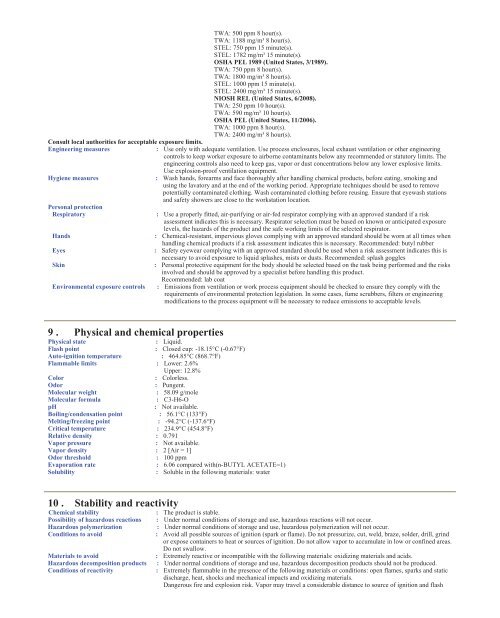Print MSDS - Miller Electric Company Publications
Print MSDS - Miller Electric Company Publications
Print MSDS - Miller Electric Company Publications
Create successful ePaper yourself
Turn your PDF publications into a flip-book with our unique Google optimized e-Paper software.
TWA: 500 ppm 8 hour(s).<br />
TWA: 1188 mg/m³ 8 hour(s).<br />
STEL: 750 ppm 15 minute(s).<br />
STEL: 1782 mg/m³ 15 minute(s).<br />
OSHA PEL 1989 (United States, 3/1989).<br />
TWA: 750 ppm 8 hour(s).<br />
TWA: 1800 mg/m³ 8 hour(s).<br />
STEL: 1000 ppm 15 minute(s).<br />
STEL: 2400 mg/m³ 15 minute(s).<br />
NIOSH REL (United States, 6/2008).<br />
TWA: 250 ppm 10 hour(s).<br />
TWA: 590 mg/m³ 10 hour(s).<br />
OSHA PEL (United States, 11/2006).<br />
TWA: 1000 ppm 8 hour(s).<br />
TWA: 2400 mg/m³ 8 hour(s).<br />
Consult local authorities for acceptable exposure limits.<br />
Engineering measures : Use only with adequate ventilation. Use process enclosures, local exhaust ventilation or other engineering<br />
controls to keep worker exposure to airborne contaminants below any recommended or statutory limits. The<br />
engineering controls also need to keep gas, vapor or dust concentrations below any lower explosive limits.<br />
Use explosion-proof ventilation equipment.<br />
Hygiene measures<br />
Personal protection<br />
: Wash hands, forearms and face thoroughly after handling chemical products, before eating, smoking and<br />
using the lavatory and at the end of the working period. Appropriate techniques should be used to remove<br />
potentially contaminated clothing. Wash contaminated clothing before reusing. Ensure that eyewash stations<br />
and safety showers are close to the workstation location.<br />
Respiratory : Use a properly fitted, air-purifying or air-fed respirator complying with an approved standard if a risk<br />
assessment indicates this is necessary. Respirator selection must be based on known or anticipated exposure<br />
levels, the hazards of the product and the safe working limits of the selected respirator.<br />
Hands : Chemical-resistant, impervious gloves complying with an approved standard should be worn at all times when<br />
handling chemical products if a risk assessment indicates this is necessary. Recommended: butyl rubber<br />
Eyes : Safety eyewear complying with an approved standard should be used when a risk assessment indicates this is<br />
necessary to avoid exposure to liquid splashes, mists or dusts. Recommended: splash goggles<br />
Skin : Personal protective equipment for the body should be selected based on the task being performed and the risks<br />
involved and should be approved by a specialist before handling this product.<br />
Recommended: lab coat<br />
Environmental exposure controls : Emissions from ventilation or work process equipment should be checked to ensure they comply with the<br />
requirements of environmental protection legislation. In some cases, fume scrubbers, filters or engineering<br />
modifications to the process equipment will be necessary to reduce emissions to acceptable levels.<br />
9 . Physical and chemical properties<br />
Physical state : Liquid.<br />
Flash point : Closed cup: -18.15°C (-0.67°F)<br />
Auto-ignition temperature : 464.85°C (868.7°F)<br />
Flammable limits : Lower: 2.6%<br />
Upper: 12.8%<br />
Color : Colorless.<br />
Odor : Pungent.<br />
Molecular weight : 58.09 g/mole<br />
Molecular formula : C3-H6-O<br />
pH : Not available.<br />
Boiling/condensation point : 56.1°C (133°F)<br />
Melting/freezing point : -94.2°C (-137.6°F)<br />
Critical temperature : 234.9°C (454.8°F)<br />
Relative density : 0.791<br />
Vapor pressure : Not available.<br />
Vapor density : 2 [Air = 1]<br />
Odor threshold : 100 ppm<br />
Evaporation rate : 6.06 compared with(n-BUTYL ACETATE=1)<br />
Solubility : Soluble in the following materials: water<br />
10 . Stability and reactivity<br />
Chemical stability : The product is stable.<br />
Possibility of hazardous reactions : Under normal conditions of storage and use, hazardous reactions will not occur.<br />
Hazardous polymerization : Under normal conditions of storage and use, hazardous polymerization will not occur.<br />
Conditions to avoid : Avoid all possible sources of ignition (spark or flame). Do not pressurize, cut, weld, braze, solder, drill, grind<br />
or expose containers to heat or sources of ignition. Do not allow vapor to accumulate in low or confined areas.<br />
Do not swallow.<br />
Materials to avoid : Extremely reactive or incompatible with the following materials: oxidizing materials and acids.<br />
Hazardous decomposition products : Under normal conditions of storage and use, hazardous decomposition products should not be produced.<br />
Conditions of reactivity : Extremely flammable in the presence of the following materials or conditions: open flames, sparks and static<br />
discharge, heat, shocks and mechanical impacts and oxidizing materials.<br />
Dangerous fire and explosion risk. Vapor may travel a considerable distance to source of ignition and flash



